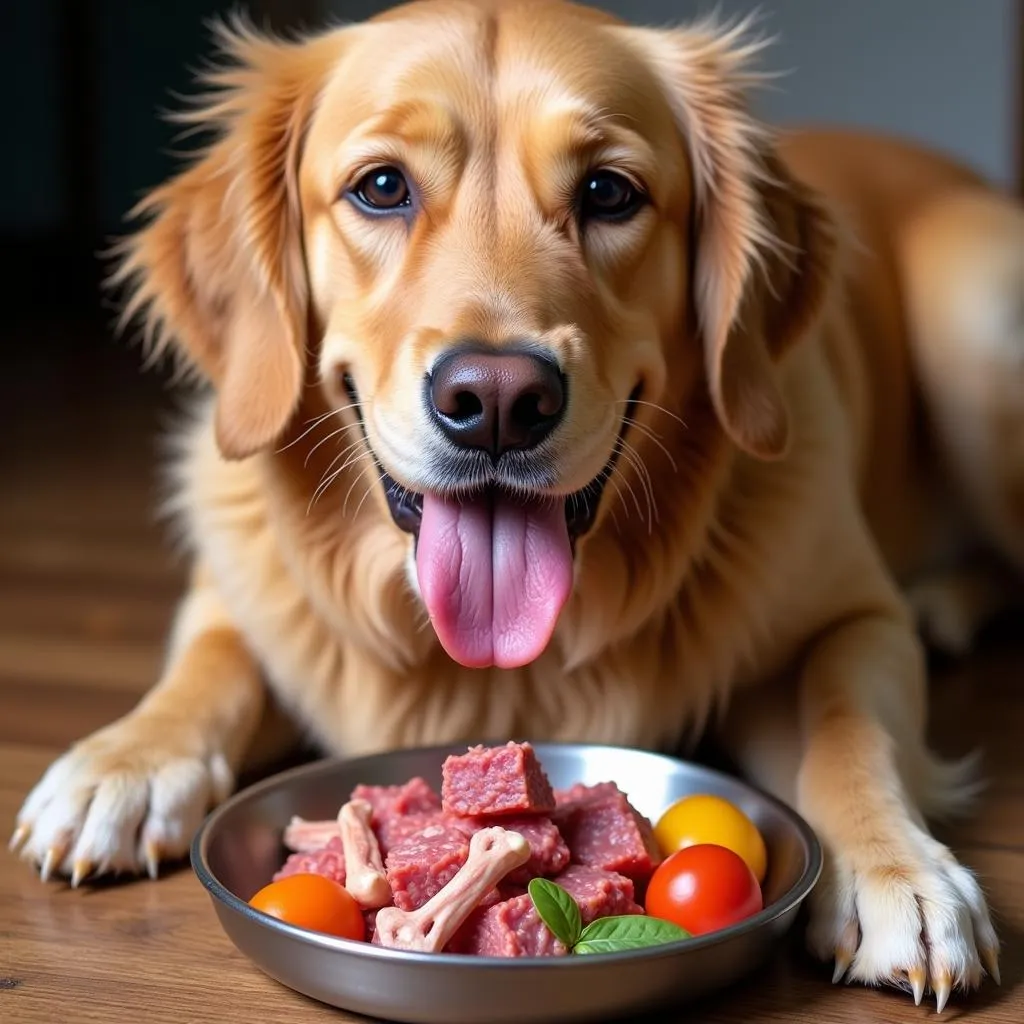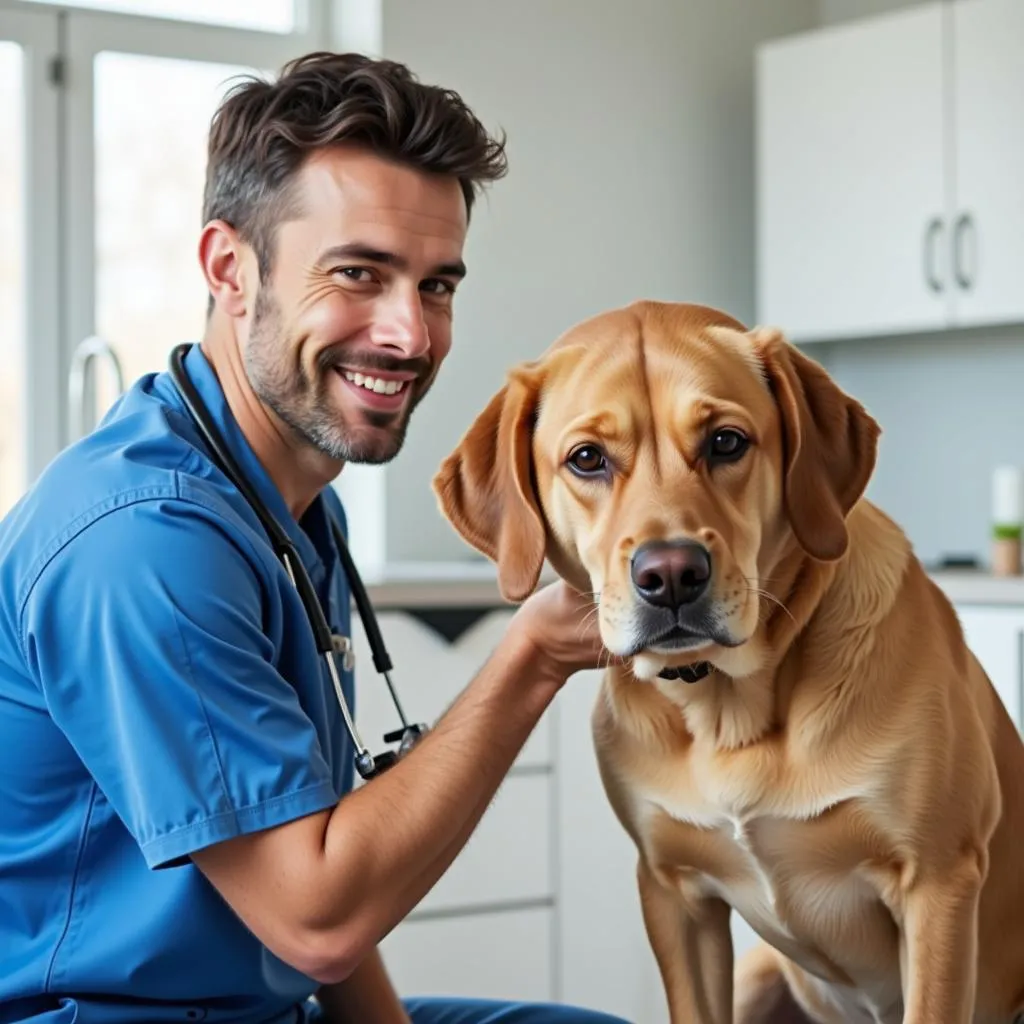Raw dog food is gaining popularity across the USA, and for good reason. This dietary approach focuses on providing dogs with uncooked, unprocessed ingredients like muscle meat, bones, organs, fruits, and vegetables. This mimics the diet their ancestors thrived on in the wild and can offer a range of health benefits. But switching to raw feeding isn’t a decision to be taken lightly. Let’s delve deeper into the world of raw dog food in the USA, exploring its benefits, drawbacks, and what to consider before making the switch.
Why are US Pet Owners Turning to Raw Dog Food?
More and more US pet owners are questioning conventional kibble and exploring alternative diets like raw feeding.  Golden Retriever Enjoying Raw Dog Food This shift stems from a desire to provide their furry companions with the most natural and nutritious diet possible.
Golden Retriever Enjoying Raw Dog Food This shift stems from a desire to provide their furry companions with the most natural and nutritious diet possible.
Here are some of the key reasons why raw dog food is becoming increasingly popular in the USA:
- Improved Digestion: Raw food proponents argue that dogs, with their shorter digestive tracts, are better equipped to digest raw food than processed kibble. Raw food is often reported to lead to better nutrient absorption, firmer stools, and less gas.
- Shinier Coat, Healthier Skin: Many raw feeders report noticing a significant improvement in their dogs’ skin and coat health. This is often attributed to the natural oils and nutrients present in raw ingredients.
- Increased Energy Levels: A raw diet, rich in natural proteins and fats, can provide dogs with sustained energy levels, making them more active and playful.
- Dental Hygiene: Chewing on raw meaty bones can help clean teeth and massage gums, promoting good dental hygiene.
- Potential Allergies: Some dogs struggle with allergies to ingredients commonly found in commercial kibble. Switching to a raw diet with limited ingredients can potentially alleviate these allergies.
Navigating the World of Raw Dog Food: What to Consider
While raw feeding can offer benefits, it’s essential to approach it with careful consideration and research:
1. Sourcing Quality Ingredients
The foundation of a healthy raw diet is high-quality, human-grade ingredients. Look for:
- Meat from reputable sources: Choose meat that is free from antibiotics and hormones.
- Variety is Key: Offer a variety of protein sources like beef, chicken, fish, and organ meats to ensure a balanced nutrient profile.
- Fresh Fruits & Veggies: Incorporate a range of fresh, organic fruits and vegetables.
2. Balancing the Diet
Creating a balanced raw diet requires careful planning. Consult with a veterinarian or a certified canine nutritionist to determine the right proportions of meat, bone, organs, fruits, and vegetables for your dog’s age, breed, and activity level.
3. Food Safety
Handling raw meat always carries inherent risks. Practice meticulous hygiene:
- Wash your hands: Thoroughly wash your hands with soap and water before and after handling raw food.
- Sanitize Surfaces: Disinfect all surfaces that come into contact with the food.
- Store Properly: Keep raw meat frozen and thaw it in the refrigerator when needed.
4. Transitioning to Raw
Switching your dog to a raw diet should be a gradual process. Start by introducing small amounts of raw food alongside their existing diet and gradually increase the ratio over a week or two. This helps their digestive system adapt.
Addressing Common Concerns About Raw Dog Food
There are often misconceptions surrounding raw feeding. Let’s address some common concerns:
- Bacterial Contamination: While the risk of bacterial contamination is real, it can be minimized with proper hygiene and handling.
- Nutritional Deficiencies: With careful planning and potentially working with a canine nutritionist, you can ensure your dog receives all the essential nutrients.
- Cost: Raw feeding can be more expensive than kibble, especially if you’re sourcing high-quality ingredients.
Is Raw Dog Food Right for Your Canine Companion?
Ultimately, the decision of whether or not to transition your dog to a raw food diet is a personal one. Consider your dog’s individual needs, your lifestyle, and consult with your veterinarian to make an informed choice.
 Veterinarian Examining a Dog for Raw Feeding Suitability
Veterinarian Examining a Dog for Raw Feeding Suitability
FAQs about Raw Dog Food in the USA
1. Where can I buy raw dog food in the USA?
Raw dog food is becoming increasingly available in the USA. You can find it at specialty pet stores, some grocery stores, and online retailers.
2. How much raw food should I feed my dog?
The amount of raw food your dog needs varies depending on their age, breed, size, activity level, and metabolism. It’s best to consult with your veterinarian or a canine nutritionist for personalized guidance.
3. Can puppies eat raw food?
Yes, puppies can thrive on a raw diet. However, their nutritional needs are different from adult dogs. Consult with your veterinarian for a balanced puppy-specific raw food plan.
4. Is it safe to feed raw bones to my dog?
Raw meaty bones can be a great addition to a raw diet, providing mental stimulation and dental benefits. However, always supervise your dog when they’re chewing on bones and choose bones that are appropriately sized for their breed.
5. What are some signs that my dog might be doing well on raw food?
Signs your dog might be thriving on raw food include: improved digestion (smaller, firmer stools), increased energy levels, shinier coat, healthier skin, and reduced allergies.
Need More Guidance on Raw Dog Food?
Switching to raw feeding is a big decision. If you’re seeking more information or have any questions, don’t hesitate to contact us. Our team at Mina Cones Food is here to help guide you on your raw feeding journey. Call us at 02437655121, email us at [email protected], or visit our location at 3PGH+8R9, ĐT70A, thôn Trung, Bắc Từ Liêm, Hà Nội, Việt Nam. We offer 24/7 customer service to support you every step of the way.